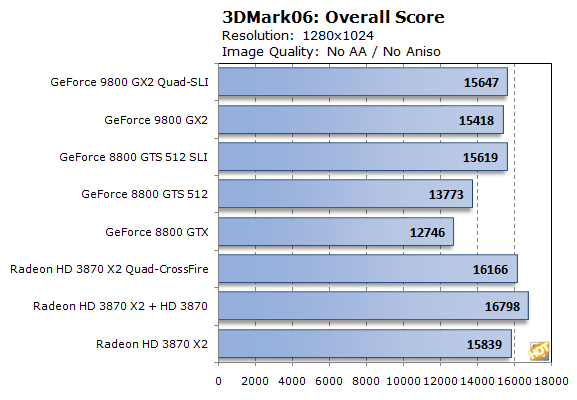NVIDIA Quad-SLI with the ASUS EN9800GX2
Our Test Systems and 3DMark06

HOW WE CONFIGURED THE TEST SYSTEMS: We have two sets of benchmark tests to discuss in this article. The first round of tests consist of five different motherboards compared using identical supporting hardware. In addition to the motherboard tests, we also tested all of the graphics cards used in this article on either an Asus nForce 790i SLI Ultra based Striker II Extreme motherboard (NVIDIA GPUs) or an Asus P5E3 Premium (ATI GPUs) powered by a Core 2 Extreme QX6850 quad-core processor and 2GB of low-latency Corsair RAM. The first thing we did when configuring these test systems was enter their respective BIOSes and set all values to their "optimized" or "high performance" default settings. Then we manually configured the memory timings and disabled any integrated peripherals that wouldn't be put to use. The hard drive was then formatted, and Windows Vista Ultimate was installed. When the installation was complete we fully updated the OS, and installed the latest DX10 redist and various hotfixes, along with the necessary drivers and applications.
|
|
|
|
Asus Striker II Extreme Asus P5E3 Premium Radeon HD 3870 X2 (x2) 2048MB Corsair DDR3-1333 C7 Integrated Audio |
Relevant Software: Windows Vista Ultimate NVIDIA Forceware v174.53 |
|
|
|
|
|
3DMark06 is the most recent addition to the 3DMark franchise. This version differs from 3Dmark05 in a number of ways, and includes not only Shader Model 2.0 tests, but Shader Model 3.0 and HDR tests as well. Some of the assets from 3DMark05 have been re-used, but the scenes are now rendered with much more geometric detail and the shader complexity is vastly increased as well. Max shader length in 3DMark05 was 96 instructions, while 3DMark06 ups that number to 512. 3DMark06 also employs much more lighting and there is extensive use of soft shadows. With 3DMark06, Futuremark has also updated how the final score is tabulated. In this latest version of the benchmark, SM 2.0 and HDR / SM3.0 tests are weighted and the CPU score is factored into the final tally as well. |

According to 3DMark06's default benchmark, the various Radeon HD 3870 X2 CrossFireX configurations have an advantage over the GeForce 9800 GX2 and Quad-SLI in general. Why that is the case with this benchmark reveals itself if we look at the individual test results.


3DMark06's Shader Model 2.0 test is essentially CPU bound with all of the multi-GPU configurations, but the ATI powered configurations held onto a slight lead. In the Shader Model 3.0 / HDR test though, the ATI-powered rigs scaled to a larger degree, which boosted the overall results.







